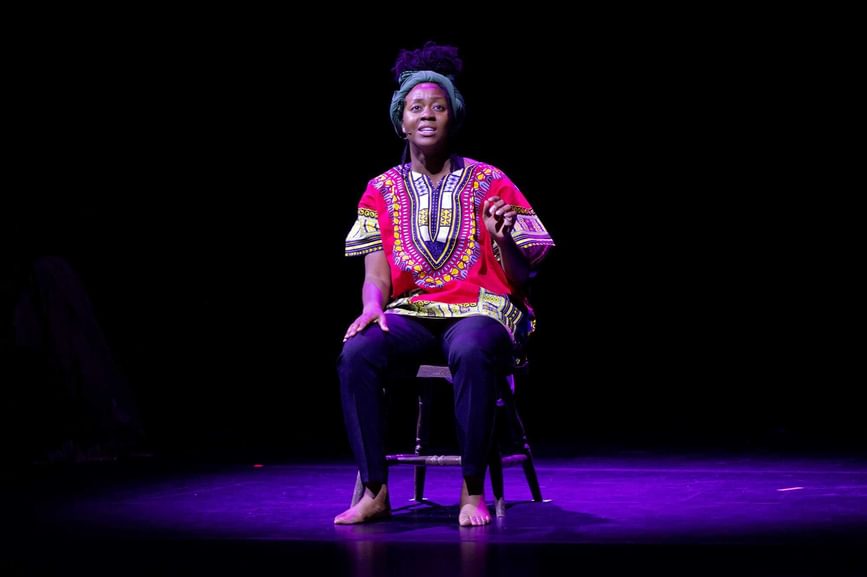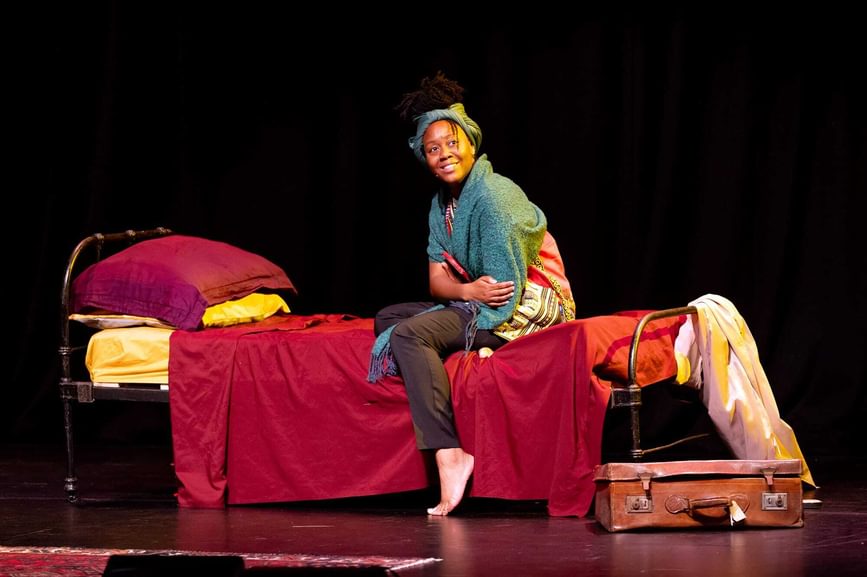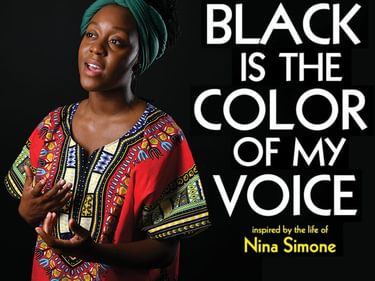News Story
In October 2024, we welcomed a play inspired by the life and music of Nina Simone. Black is the Color of My Voice is a timely piece for Black History Month here in Worthing. It celebrates an important political figure in Black history, who was spurred by the injustices she faced to influence change through her art. We caught up with actor, Nicholle Cherrie to find out more.
What’s the play about?
Apphia Campbell’s acclaimed play follows a successful singer and civil rights activist seeking redemption after her father’s untimely death. She reflects on the journey that took her from a young piano prodigy, destined for a life in the church's service, to a renowned jazz vocalist at the forefront of the Civil Rights Movement. Inspired by the life of Nina Simone, it features many of her most iconic songs, performed live. It celebrates the story of a passionate and talented woman on a self-reflective journey.

Nicholle Cherrie performing Black is the Color of My Voice in Edinburgh.
Credit: Rod PennAbout Nina Simone
Nina Simone was an American musician, composer and civil rights activist. Born Eunice Kathleen Waymon in 1933, she adopted her stage name to disguise herself from her religious family. She knew her mother, a Methodist preacher, would disapprove of her working as a jazz musician in bars. As a black woman, she experienced intense racial prejudice and social inequalities first-hand throughout her life. Her experiences and friendships with other activists inspired her to use her music in the fight for justice.
The Musician
Having shown a great affinity for music at a young age, Simone made her recital debut in her local church at age 12. She later recounted that her parents were seated in the front row for this performance. However, they were made to move to the back to make way for some white people. Simone stopped playing and refused to continue until her parents returned to their original seats. This moment lit a fire within Simone, fuelling her political and social activism later in life.
Simone's success as a recording artist was a means to an end. She was more interested in continuing her studies as a classical musician. However, in the mid-1960s, her songwriting focused more on the subject of racism in America.
The Activist
Simone later recalled how ‘Mississippi Goddam’ (1964) was her first civil rights song. It was written “in a rush of fury, hatred and determination”. The song came to her following racially fueled acts of terrorism against black people and communities in 1963. Many of Simone’s most well-known songs, such as ‘I Wish I Knew’ (1967), were protest songs reflecting on race relations. In 1969, Simone appeared at the Harlem Cultural Festival. She performed a new civil rights song, ‘Young Gifted and Black’, named after an unfinished play by her late friend Lorraine Hansberry. Simone credited Hansberry with cultivating her social and political consciousness. The performance was recorded and can now be seen as part of Questlove’s 2021 documentary Summer of Soul.
Simone was heavily involved in the civil rights movement throughout the 1960s. She spoke at meetings such as the Selma to Montgomery Marches in 1965. Although she took part in these nonviolent demonstrations, her views were more aligned with those of Malcolm X, her neighbour in New York, who advocated for a violent revolution.

Nina Simone in 1969
Credit: Gerrit de BruinReclaiming Narratives
The theme of this year’s UK Black History Month is Reclaiming Narratives. It is an invitation and a call to action. The theme asks black communities to take on the role of the storytellers of their own heritage and encourages communities to take ownership of the important contributions of black people to politics, society, and culture.
It’s time to take control of our stories, celebrate our heritage, and ensure our voices are heard… stories are powerful tools that shape how we understand our past, present, and future
To that end, the breadth of Nina Simone’s cultural and political impact cannot be fully explored in just one summary post here on our blog. We encourage audiences to seek out the narrative for themselves. Black is the Color of My Voice is crafted by talented black creatives and is a compelling tribute to Simone’s undeniable impact and influence.
We caught up with Nicholle Cherrie, who performs the piece, to learn more about her work and the play.

Nicholle Cherrie performing Black is the Color of My Voice in Edinburgh.
Credit: Rod PennQ&A With Nicholle Cherrie
What can audiences expect from Black is the Color of My Voice – without giving too much away?
Expect to be taken on a journey. Expect to smile, maybe cry. You’re like a fly on the wall peering into a beautifully intimate story. You will also experience a reimagining of Nina Simone’s songs, which explores the genres of soul, jazz, folk, gospel, and blues music.
Nina Simone is an icon in the Civil Rights Movement as an activist and a musician. How did you approach developing your character, and sharing this story?
Black is the Color of My Voice is not a direct portrayal of Nina Simone’s life, but it is heavily inspired by it. When approaching the character of Mena, I chose to pick out certain qualities in Nina. Stage presence and passion; the way she speaks with conviction, her quality of movement, and apply it to the character. I also did some research into the US civil rights movement and watched interviews to get a better understanding of the context before working with the text.
Simone’s music is integral to her story as a political figure and social commentator. Does this have an impact on the way you perform the songs in the performance?
Definitely. As an artist and performer, I love when people to engage with my work and feel something, anything, whatever they need to take away from the music. But when it comes to protest/activist songs like those featured in the play, the message is more direct. It’s at the heart of every sound you make. So naturally, my performance becomes more focused.

Nicholle Cherrie performing Black is the Color of My Voice in Edinburgh.
Credit: Rod PennHave you put your own spin on performing them, or have you tried to remain true to Simone’s style?
I’d like to say that I channel Nina Simone’s energy into the way I perform. But it’s still very much my own take on the character and my sound. It’s a nice blend.
What are some of the biggest challenges you faced in working on this piece?
The time frame — we had 10 days of rehearsals, which was crazy, but we made it. The post-show cool down is also key. I make sure I take some time to reset before going home. It is quite a journey to go through every night.
What have you enjoyed most about the process?
I love the music. I don’t often get to sing in this style or vocal range when I perform. So, it’s been beautiful to experience.
What do you see as the main challenges young black artists in the performing arts industry today?
The versatility of Black characters and storylines. I think broadening the casting and what is shown in mainstream theatres would help. It’s hard to retell traumatic stories repeatedly. There’s so much more that we want to see that shows the Black experience — in all its range and beauty.
This year’s focus for Black History Month is Reclaiming Narratives. Tell us why you feel this is an important theme to celebrate, and how it relates to the work you have done in telling this story.
In a world where people often try to label you or put you in a box, it’s important to be reminded that you have your own choices. This is especially true for Black people. Our work encourages young Black children to dream big. They can achieve anything they put their minds to, even in the face of adversity.
The show invites people to explore and go with their hearts. The activism continues even today, and by making the character in the story Mena rather than specifically Nina Simone, it opens up the potential for audiences to really relate to the human onstage.

Nicholle Cherrie performing Black is the Color of My Voice in Edinburgh.
Credit: Rod Penn